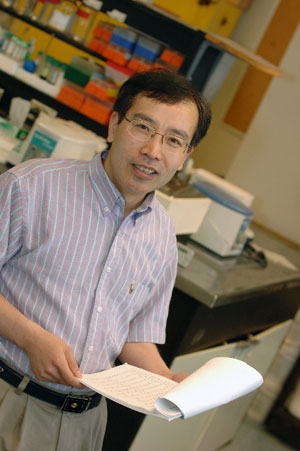 |
| Dr. Paul Liu, professor in the Department of Biochemistry and Molecular Biology, is a leader in the field of intein research. (Danny Abriel Photo) |
It’s the ugly duckling story of the molecular world. Intein, thought two decades ago to be nothing more than a molecular parasite or a harmless hitchhiker, is today an invaluable tool in the ever-important field of protein research.
“Inteins were originally found in nature and seen as an oddity before we knew their function,” says Dr. Paul Liu, professor in the department of Biochemistry and Molecular Biology. “But with greater research curiosity, more was understood about their usefulness and they attracted wider attention.”
Dr. Liu was recently awarded $120,000 from the Natural Sciences and Engineering Research Council of Canada (NSERC) to study the evolutionary and functional versatility of inteins. The funding will also help Dr. Liu replace his graduating students with new students without a gap in training.
The first to discover intein-splitting, his group develops intein-based protein splicing technology for various applications. Now, protein fragments can be pieced together to form larger ones leading to new pathways for researchers to make proteins, whereas before they could only split them – like “cutting and pasting.”
The splicing has allowed for segment labeling in protein nuclear magnetic resonance spectroscopy (NMR), a process used to study the structure and dynamics of proteins – the molecules responsible for making us do the things we do, our health, the things that make us tick.
In fact, Dr. Liu’s group collaborates with laboratories in the U.S. to overcome difficulty in gene therapy. “In past cases large genes couldn’t be delivered into a person’s cells,” explains Dr. Liu. “Now you can deliver smaller proteins to the gene and splice them together once there.”
One of the most interesting prospects of intein research is that it may finally be the key to creating spider-silk. For centuries many have tried — unsuccessfully — to create the substance, the strongest fibre known to humans. While the silk-like fibre is made of proteins, it can’t be made in cells with recombinant (artificial) proteins. However, as Dr. Liu explains, with the use of intein-splitting, it may be possible to produce proteins fragment by fragment and splice them into spider-silk.
So, Will Spiderman one day be swinging past your office window? Stay tuned.
Comments
comments powered by Disqus
